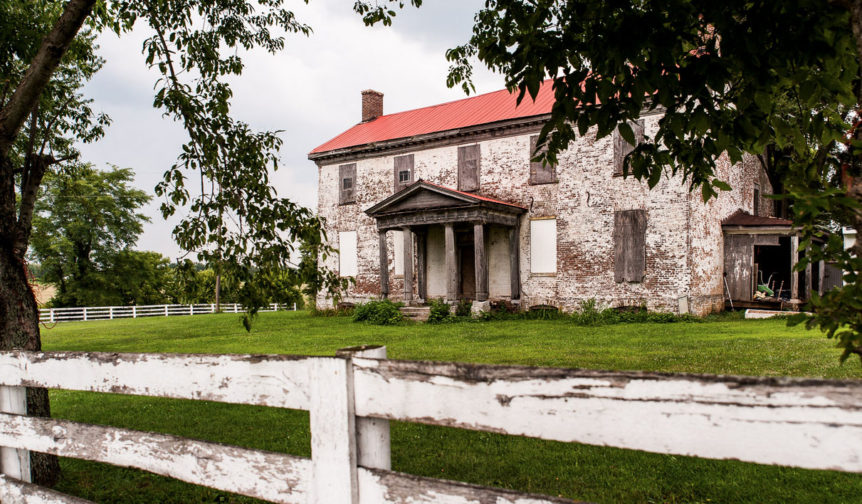For almost twenty years Sherman Cahal has traveled the Middle West and Appalachia, photographing residential, industrial, and commercial buildings that exist in various states of disrepair and decay, creating a visual record that is, of course, sad, but that also invokes the peculiar appeal of old, worn things. Cahal catalogues his travels in a photo project he calls “Abandoned,” which appears on a website he has maintained since 1998.

Parts of this eleven-room brick house date to the early 1790s. The original structure was built by Colonel Abram Buford on a tract of several thousand acres he received for his service in the Revolutionary War. His daughter, Mary, and her husband, James K. Duke—famed for their lavish parties and fine stable of thoroughbreds—enlarged the house in 1833. The pasture in front of the house was a favorite dueling ground in the mid nineteenth century.
Cahal grew up in a small town on the Ohio River named Raceland (“not Graceland,” he emphasizes), in what he calls a “rust belt-type situation” where “general dismay and doom and gloom” caused by in dustrial decline were part of life. He makes work that is distinguished by a sensitivity to the history of places and to the craft of builders. Details such as the rippling rococo ceiling moldings and ornate cornice brackets of a country house in Kentucky or the ornate tympanum above a door in Pittsburgh—architectural heritage that has been altered by the vagaries of weather and the stewardship of squatters—regain much of their dignity through his lens.
Cahal says he is fascinated by the responses the project elicits. “My friend lived in one of the houses in this row in Jewell Valley [and] I remember sitting in the living room playing guitar,” reads one online comment on photos of the deserted coal mining town of Jewell Valley, Virginia. “All of the land in that area has changed. The [coal] tipples are gone, the land has mostly been reclaimed and only these empty shells of houses remain, but the memories of those that passed through these places are still fresh.”
Part sociology, part archaeology, and part artistry, Cahal’s project breathes new life into places that might otherwise have been left for dead.
Chateau Street row houses, Pittsburgh, Pennsylvania
Cahal photographed this group of four late nineteenth-century brick row houses in the Manchester neighborhood not long before they were demolished in 2013. They had been vacant nearly thirty years. Though the buildings lay within the boundaries of a Pittsburgh historic district, they were not deemed significant enough to merit the estimated 1.2 million in rehabilitation costs. “There’s a lot of buildings just like them in Manchester,” said a member of a neighborhood citizens’ committee, “and we can’t save them all.”



House on Burton Pike, Scott County, Kentucky
Located on a rural byway known as Burton Pike, this antebellum house, shaded by mulberry trees, stands on a fourteen hundred-acre plot in northern Kentucky. American Indian burial mounds are a common find in the area, where the Adena culture thrived for a millennium, a reminder of other long-gone inhabitants. The mostly intact Greek revival entrance and luxurious wood paneling inside point to the abode’s former elegance, even as bottles, boxes, and other detritus accumulate in its rooms.

William Tarr house, near Millersburg, Kentucky
In use until 1985, the William Tarr house was built in the midnineteenth century by A. J. Hitt, who ran a flour- and gristmill in nearby Millersburg, Kentucky. Tarr later updated the original Federal style design with Italianate features such as the inset balustraded balcony and embellished cornices. “It’s still got good bones, solid brick walls, curved brick walls,” Cahal says, referring to details that had to have been carved by hand. “You don’t see this unless you’re looking at antebellum residences. After [the war] the styling changed.”




Jewell Valley, Buchanan County, Virginia
Evidence of a drama that has played out countless times in Appalachia, rundown company houses are all that remain of a once prosperous Virginia mining town. Built by coal and railroad kingpin George L. Carter in the 1930s, the unincorporated community of Jewell Valley runs alongside Dismal Creek in Buchanan County. In those days, the county was believed to be home to more millionaires than any other in the commonwealth. The lights dimmed in Jewell Valley in the early 1970s, a decade after mining shut down there. The town currently has a population of two.




Sherman Cahal’s photography can be seen at abandonedonline.net

